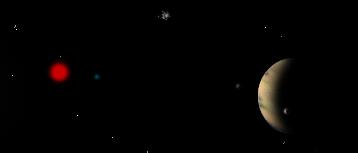Other Methods for Finding Planets..
Astrometric Technique
Transiting Planets
Found when the planet passes in front of the star, causing the light from the star
to dim slightly for a short period of time.
A list of all published planet finds here.
(updated often). Its clear 'Doppler Spectroscopy' is the most effective method of finding
extrasolar planets.
How did a gas giant form so close to the Star?
The planets have moved! Only one star-planetary system has been found based on seeing the star wobble
in the sky. The star is
Only one star-planetary system has been found based on seeing the star wobble
in the sky. The star is  Planets around Pulsars
Planets around Pulsars
The first planets to be discovered were around pulsars! Pulsars emit
a very regular radio signal, which allows Doppler shifts to be measured
with extremely
high accuracy (see here). Several planets around a few pulsars have been identified and
they have terrestrial masses, similar to Earth. However, it is unlikely life
could exist on such planets. Pulsars are created when massive stars go supernova,
and this would certainly have killed anything already on the planet. Now, the
amount of radiant energy is too low for life to take hold.
The first planets to be found would naturally be massive and near their parent
star. Click HERE to see
the orbital distances of all the planets known so far (last year's
HERE). Almost all of them
are within just a few AU. Jupiter formed farther from
the Sun, at 5.2 AU, where ices were abundant. At nearer distances only small
planets can form because the high gas temperature in the inner
proto-planetary disk keeps ices from being available to form into
planetesimals. Or, maybe these close planets are not stable? See evidence
of an Evaporating World!
For some of the stars, they are lower mass than the Sun and burn much cooler
(like the Red Dwarfs), and this might allow giant planets to form a bit closer.
Most believe the big planets formed farther out and have
since migrated closer in. Interactions with other giant planets and/or debris
may have caused this.